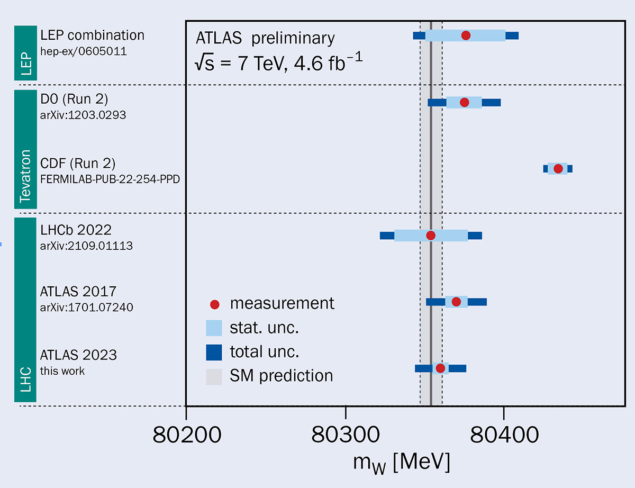
Since the discovery of the W boson at the SppS 40 years ago, collider experiments at CERN and elsewhere have measured its mass ever more precisely. Such measurements provide a vital test of the Standard Model’s consistency, since the W mass is closely related to the strength of the electroweak interaction and to the masses of the Z boson, top quark and Higgs boson; higher experimental precision is needed to keep up with the most recent electroweak calculations.
The latest experiment to weigh in on the W mass is ATLAS. Reanalysing a sample of 14 million W candidates produced in proton–proton collisions at 7 TeV, the collaboration finds Mw = 80.360 ± 0.005(stat) ± 0.015(syst) = 80.360 ± 0.016 GeV. The value, which was presented on 23 March at the Rencontres de Moriond, is in agreement with all previous measurements except one – the latest measurement from the CDF experiment at the former Tevatron collider at Fermilab.
In 2017 ATLAS released its first measurement of the W-boson mass, which was determined using data recorded in 2011 when the LHC was running at a collision energy of 7 TeV (CERN Courier January/February 2017 p10). The precise result (80.370 ± 0.019 GeV) agreed with the Standard Model prediction (80.354 ± 0.007 GeV) and all previous experimental results, including those from the LEP experiments. But last year, the CDF collaboration announced an even more precise measurement, based on an analysis of its full dataset (CERN Courier May/June 2022 p9). The result (80.434 ± 0.009 GeV) differed significantly from the Standard Model prediction and from the other experimental results (see figure), calling for more measurements to try to identify the source of the discrepancy.
In its new study, ATLAS reanalysed its 2011 data sample using a more advanced fitting technique as well as improved knowledge of the parton distribution functions that describe how the proton’s momentum is shared amongst its constituent quarks and gluons. In addition, the collaboration verified the theoretical description of the W-production process using dedicated LHC proton–proton runs. The new result is 10 MeV lower than the previous ATLAS result and 15% more precise.
“Due to an undetected neutrino in the particle’s decay, the W-mass measurement is among the most challenging precision measurements performed at hadron colliders. It requires extremely accurate calibration of the measured particle energies and momenta, and a careful assessment and excellent control of modelling uncertainties,” says ATLAS spokesperson Andreas Hoecker. “This updated result from ATLAS provides a stringent test and confirms the consistency of our theoretical understanding of electroweak interactions.”
The LHCb collaboration reported a measurement of the W mass in 2021, while the results from CMS are keenly anticipated. In the meantime, physicists from the Tevatron+LHC W-mass combination working group are calculating a combined mass value using the latest measurements from the LHC, Tevatron and LEP. This involves a detailed investigation of higher-order theoretical effects affecting hadron-collider measurements, explains CDF representative Chris Hays from the University of Oxford: “The aim is to give a comprehensive and quantitative overview of W-boson mass measurements and their compatibilities. While no significant issues have been identified that significantly change the measurement results, the studies will shed light on their details and differences.”
Further reading
ATLAS Collaboration 2023 ATLAS-CONF-2023-004.





